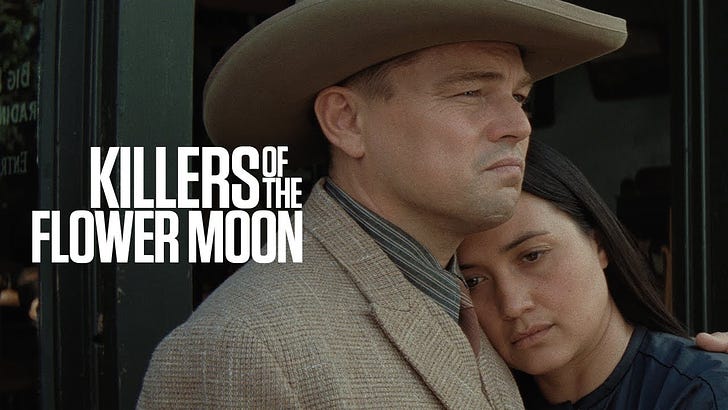The discovery of oil on the Osage Reservation in northeastern Oklahoma in 1897 soon made the Osage people the wealthiest per capita in the United States. The US government, through the Bureau Of Indian Affairs, managed the oil extraction and paid royalties to those who owned the “headrights.” Rather than just paying the Osage, however, the BIA required those with half or more Osage ancestry to have guardians manage their money for them. In practice, this meant the Osage needed permission from these guardians, who were white men, to gain access to their own money.
As it turns out, guardianship fees were just one way of exploiting the Osage. Many white men married Osage women, thereby gaining inheritance rights to the land and oil royalties. During the early twentieth century, dozens of Osage were murdered or died mysterious deaths. Local and state law enforcement seldom pursued detailed investigations, often marking the deaths as accidental or from natural causes.
This largely hidden history became more well-known outside Osage country after the publication of Killers Of The Flower Moon: The Osage Murders and the Birth of the FBI, by David Grann in 2017. Grann’s detailed research reported on several of the murders, and how the Bureau Of Investigation (a precursor to the FBI) helped solve at least some of them.
Martin Scorsese adapted the book into a three and a half hour movie with Robert De Niro and Leonardo DiCaprio as an uncle and nephew, and Lily Gladstone as an Osage woman. As the story begins, Ernest Burkhart (DiCaprio), is returning from The Great War. His uncle William Hale (De Niro) takes him under his wing, counseling him on ways to make money. He soon meets Mollie Kyle (Gladstone), who along with her mother and sisters, is one of the wealthy and single Osage in town.
The romance that blossoms between Ernest and Mollie, is undercut by his willingness to be manipulated by Hale. As one death after another occurs, some violent some not, we witness the scope of the corruption enabling the killers. Police, judges, coroners, doctors, lawyers and others either take part in the killings, or do their part to cover up the circumstances of the deaths. In Scorcese’s telling, Hale, who fancies himself the “King” of Osage country, ruthlessly conspires with his nephews Ernest and Byron to kill a host of Osage who stand in the way of acquiring the land and oil rights. Neither Ernest nor Byron appear troubled by the criminal conspiracy, with Ernest frequently telling people “I love money.”
Early in the story, Hale tells Ernest that the Osage are among the smartest people he has ever met. They don’t always speak much, he warns Ernest, but they observe everything. So it is with Gladstone’s performance as Mollie Kyle. Her screen time is significant, even if her lines of dialog are short. Yet watching her face size up the other characters in her scenes is a real treat. Her eyes constantly search for meaning in the situation at hand. She asks pointed questions, or makes pointed observations, revealing her insights.
She is also a woman not to be defined by others. When Ernest, during their courtship, admiring her skin tone asks “what color is that?” She responds, “My color.” Her performance, though less blustery than either De Niro or DiCaprio, stands out as award worthy
Somewhere around the two hour mark Tom White (Jesse Plemons) arrives from the Bureau Of Investigation to look into the string of unsolved murders and mysterious deaths. As the case winds to its conclusion, Hale and Burkhart slowly lose control of their conspiracy. Witnesses turn up…no honor among thieves (or killers) as it is. Trials take place. Lawyers make pithy arguments Sentences are issued. And, yet, it’s hard to say the Osage received justice in the face of the deaths of so many of their people, many more than were ever investigated by the FBI.
End Notes:
Though good in their roles, De Niro and DiCaprio seem miscast. The former’s Oklahoma accent comes and goes, and his history of playing New York characters is hard to shake from the viewer’s mind. Ernest is supposed to be in his mid twenties. At 48 years old, DiCaprio just doesn’t look the part. Casting Tommy Lee Jones and Lucas Hedges, or other similar actors would have made the characters more believable.
Robbie Robertson’s score, his final film work before his recent death, is beautifully composed, and performed. It deserves consideration throughout the awards season to come.



